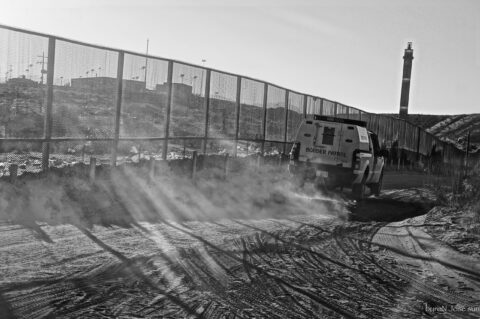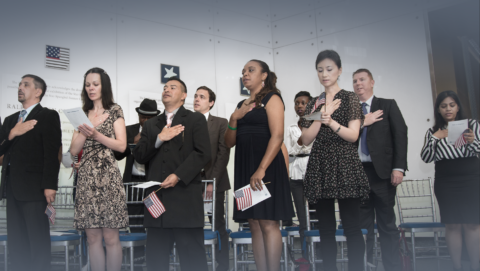Research and Analysis

Mexican and Central American Asylum and Credible Fear Claims: Background and Context
This paper addresses these issues, summarizes the concerns and experiences of numerous advocates in the field, and concludes that the credible fear and asylum process poses obstacles for applicants that far surpass the supposed abuses claimed by its detractors. Read More

No Action Taken: Lack of CBP Accountability in Responding to Complaints of Abuse
Of the 809 complaints of alleged abuse lodged against Border Patrol agents between January 2009 and January 2012, 97 percent resulted in “No Action Taken.” On average, CBP took 122 days to arrive at a decision when one was made. Read More

Removal Without Recourse: The Growth of Summary Deportations from the United States
The deportation process has been transformed drastically over the last two decades. Today, two-thirds of individuals deported are subject to what are known as “summary removal procedures,” which deprive them of both the right to appear before a judge and the right to apply for status in the United States. In 1996, as part of the Illegal Immigration Reform and Immigrant Responsibility Act (IIRIRA), Congress established streamlined deportation procedures that allow the government to deport (or “remove”) certain noncitizens from the United States without a hearing before an immigration judge. Two of these procedures, “expedited removal” and “reinstatement of removal,” allow immigration officers to serve as both prosecutor and judge—often investigating, charging, and making a decision all within the course of one day. These rapid deportation decisions often fail to take into account many critical factors, including whether the individual is eligible to apply for lawful status in the United States, whether he or she has long-standing ties here, or whether he or she has U.S.-citizen family members. In recent years, summary procedures have eclipsed traditional immigration court proceedings, accounting for the dramatic increase in removals overall. As the chart below demonstrates, since 1996, the number of deportations executed under summary removal procedures—including expedited removal, reinstatement of removal, and stipulated removal (all described below)—has dramatically increased. In Fiscal Year (FY) 2013, more than 70 percent of all people Immigration and Customs Enforcement (ICE) deported were subject to summary removal procedures. Expedited Removal (INA § 235(b)) Read More

Living in Car Culture Without a License
Community leaders in the United States increasingly recognize the contributions of immigrants to the growth of state and local economies, in both traditional and new immigrant destinations, as immigrants help revitalize declining communities and ailing economies. In recognition of these contributions, states and cities across the country are creating welcoming initiatives that seek to integrate and maximize the contributions of immigrant workers and entrepreneurs of all backgrounds, without an emphasis on legal status. On a parallel track in terms of initiatives that facilitate the integration of foreign-born arrivals, some states offer driver’s licenses to unauthorized immigrants. Many more states are considering it. This makes sense given that the United States is among the top motor-vehicle dependent countries in the world. States that do not offer driver’s licenses to unauthorized immigrants will limit the contributions that immigrant communities as a whole can potentially make, are likely to face negative economic and public safety consequences, and tend to fail in attempts to use such restrictive state-level policies to reduce the presence of unauthorized immigrants. Read More

A Guide to H.R. 15: The Border Security, Economic Opportunity, and Immigration Modernization Act
On October 2, 2013, Democrats in the House of Representatives proposed an immigration reform bill addressing border security, legalization of the undocumented, interior enforcement of immigration laws, and fixes for our dysfunctional legal immigration programs. The bill is based on S.744, the bipartisan bill passed by the Senate by a vote of 68-32 on June 27, 2013. However, the bill removes the Corker-Hoeven border security amendment and replaces it with the bipartisan House border security bill, H.R. 1417, which was passed unanimously by the Homeland Security Committee in May 2013. Read More

How the United States Immigration System Works
U.S. immigration law is very complex, and there is much confusion as to how it works. This fact sheet provides basic information about how the U.S. legal immigration system is designed. Read More

Understanding H.R. 3431: The American Families United Act
On October 30, 2013, Representatives Steve Pearce (R-NM) and Beto O’Rourke (D-TX) announced the introduction of H.R. 3431, the American Families United Act (AFUA). Co-sponsors as of January 2014 included Jim Costa (D-CA) and James McGovern (D-MA). This bipartisan immigration bill approaches immigration reform from a unique angle, focusing on amendments to the system that address the separation of immigrants from their U.S. family members. The bill expands the discretionary authority of government officials to waive minor violations of law, but does not create new mechanisms for legalizing undocumented individuals. Thus, in contrast to S. 744, the comprehensive immigration bill passed by the Senate in 2013, the AFUA focuses on a narrower group of individuals who might be eligible for lawful permanent residence under current standards if not for certain legal obstacles. Read More

Health Worker Shortages & the Potential of Immigration Policy
Foreign-born and foreign-trained professionals play an important role in the delivery of health care in the United States. This report examines the important role of immigrant doctors and nurses – many of whom have received their training abroad – in the U.S. health industry, using new Census Bureau data as well as information from numerous interviews with health industry experts. Read More

Revitalization in the Heartland of America
A potent combination of declining population growth and economic stagnation has led many cities and metropolitan regions to rethink how to reinvigorate their communities. The Midwest is a prime example of this trend. According to the Chicago Council on Global Affairs, “the Midwest cannot hope to keep up with other regions or international competitors without a vital entrepreneurial sector.” The Council notes that “immigrants, risk takers by nature, are unusually successful entrepreneurs, more than twice as likely as native-born Americans to start their own firms.” As a result, immigration is one of the strategies to which communities are repeatedly turning to fuel economic growth. A budding place-based awareness of the important contributions that new and existing immigrants make to neighborhood revitalization is seen in the increasing number of cities pursuing a nexus of immigrant welcoming, integration, and economic development initiatives. In this report, we focus on the journeys of three places—two cities and one state—in their efforts to implement strategies for future economic success that depend on immigration. The initiatives are taking place against a backdrop of tepid progress toward comprehensive federal reform of the U.S. immigration system. Read More

The Faulty Legal Arguments Behind Immigration Detainers
In late June 2012, the Supreme Court struck down three provisions of Arizona’s SB 1070 and left a fourth vulnerable to future legal challenge. As has been well documented, the Court’s rejection of SB 1070 tipped the balance in favor of federal enforcement and away from state and local enforcement of the immigration laws. But this essay explores a less obvious consequence of the Court’s decision: its implications for the viability of a critical federal enforcement mechanism: the immigration “detainer.” An immigration detainer is a piece of paper that federal immigration officials send to state and local jails requesting that they continue holding an individual for up to 48 business hours after he or she would otherwise be released, so that agents of U.S. Immigration and Customs Enforcement (ICE) can investigate the person’s status and assume custody if necessary. Also known as immigration “holds,” detainers are the key enforcement mechanism behind federal enforcement initiatives like the Criminal Alien Program and Secure Communities. There has been considerable confusion as to whether a detainer is a mere request that ICE be notified of a suspected immigration violator’s impending release, or a command by ICE that state or local officials hold a prisoner for ICE beyond the time the prisoner would otherwise be released. Independent of that question, however, the Court’s decision in Arizona v. United States identifies a more fundamental problem: that detainers may violate the Constitution and federal statutes even when honored on a voluntary basis. Read More
Make a contribution
Make a direct impact on the lives of immigrants.
